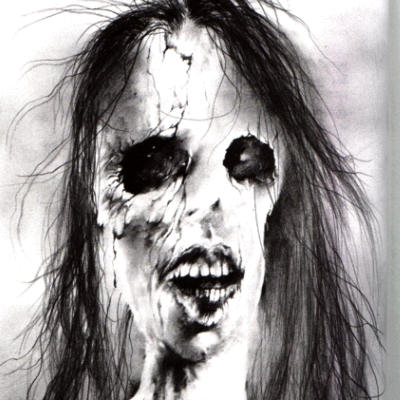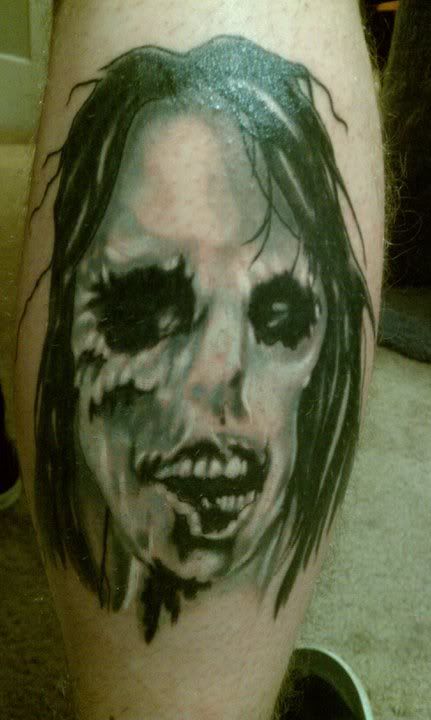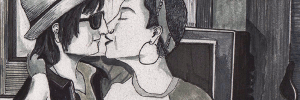 HarperCollins Has Made an Incredibly Poor Decision Regarding "Scary Stories to Tell in the Dark"
HarperCollins Has Made an Incredibly Poor Decision Regarding "Scary Stories to Tell in the Dark"You can see the differences between the two artists here.
Unreasonably anxious people have been protesting these books for thirty years and HarperCollins has finally made them happy.
Probably there is some dude shivering with delight (with the lights on) in some Midwestern apartment who claims the "Scary Stories" turned his children against him. He has been campaigning against these books for decades. Right now, he is masturbating to juicy bits from the Bible with one hand, and rubbing the hair on his nipples until he gets an electric charge with the other hand, then using this static charge to shock his own anus into orgasm.
Way to be an electrical charge in this man's anus, HarperCollins.
***
Book Fair Day was the day when we suddenly all got a crack at the dangerous books with no literary merit at all. These books were the crass, mass-culture smack that only existed to shock, titillate, amuse, provoke, confuse, and open minds to the possibilities of a larger universe beyond evil old elementary school.
This was where kids of my generation discovered "My Teacher is an Alien," and "Goosebumps," and "Redwall," and "There's a Boy in the Girl's Bathroom," and even low-calorie Stephen King, like "The Eyes of the Dragon."
But the books we all loved most (once we had outgrown Waldo (LOOK AT ALL THE NAKED MERMAIDS!!! WHERE IS THE SCROLL??? THERE IS THE SCROLL!!! WHERE IS THE WIZARD??? THERE IS THE WIZARD!!!)) were the "Scary Stories to Tell in the Dark" books.
Why did we love these books? Not for the stories. Mere campfire larks. We loved these books because of the severely fucked-up pictures.

Most of us wouldn't encounter anything as fucked-up as the "Scary Stories" books until the internet was invented, unless our teachers showed us art from post-WW1 Europe to prove a point about trauma.

***
According to Jon Ronson, one of the ways that psychologists test to see if you are psychopath is to show you graphic images and then measure your brain's electrical response to carnage, rape, violence, and murder. We all enjoy lurid imagery, it turns out. But when they show psychopaths a gruesome image and then blare an airhorn, the psychos don't even flinch. They are too fascinated. Looking at a crime-scene photo of a girl with her brains splattered on the sidewalk from a fatal gunshot wound, one woman remarked that looking at the image was like looking at a "puzzle she was trying to solve."
I feel like publishing has stopped seeing books like "Scary Stories to Tell in the Dark" as sturdy vehicles for great art and now only see them as puzzles to solve. This is also how they view their "creatives."

***
And now HarperCollins will be letting the original editions of these books go out of print, burying them forever.
This is mind-boggling:
1). These books are only successful because of the diabolical images that have burned their way into all of our brains over the past three decades, making several generations of children want to become illustrators of children's books to own the awesome power of nightmares for themselves.

2). This is the anniversary edition. Imagine being married to the same dude for thirty years, growing old together, having children together, having a great life, being very much in love. And then, on your 30th anniversary, he invites all of your friends to a big party where he brings out a totally different lady and insists -- insists! -- that he has been married to her all along and that you have to leave now. You would stand outside in the rain and stare through the window and not understand what was happening to you. Wouldn't you want your friends to be angry on your behalf and join you out there to smoke cigarettes and curse fate and say shit like "WHAT A BAFFLING CAD. HE IS NOT WORTH YOUR LOVE." Wouldn't you?
3). The new art is a little lazy. It looks exactly like art from some two-dollar erotic novel. With all due respect to Mr. Helquist, he must know that re-illustrating such an iconic book is a pretty crap career move. I feel bad for him. I'm sure they paid him well, but those are the devil's dollars.
4. With the possible exception of "The Polar Express," "Cloudy With a Chance of Meatballs," and the works of Maurice Sendak, I can hardly think of any other children's book so defined by the art style as opposed to the prose. Thinking back on these books, I can't really remember any of the stories. But I remember this:

I feel like the decision to retrofit the "Scary Stories" books was one powerful person's bad idea ("I know! If we get a DIFFERENT beloved artist to illustrate "Scary Stories," we can let the controversial version go out of print!"), and then nobody bothered to stop this person until it was too late and the powerful person was already locked into a permanent course of action involving contracts, promises, future book deals, and intern swapping.
But HarperCollins can do what it wants. I don't give a shit. This makes the books that they are not actually publishing -- the old editions with the good art -- go way up in value. Bad for them, great for early adopters.

Yeah, go nuts HarperCollins ? we will scan the old editions and make our own versions for our kids.

But HarperCollins shouldn't really be worried about bloggers, customers, censors, or even the artists involved in the production of this particular book: they should be worried about future illustrators that they intend to hire.

What this says to future illustrators is that if you do smash-hit work for them, if you do art so good that it becomes "a thing," maybe the first real art that kids ever see, if you do such good work that you win awards and cause people to get tattoos of what you have done, if you do this for HarperCollins, then you do not even have a guarantee that your name will be on the work that you made famous in your own lifetime. Your work will disappear from the catalog if somebody in a shiny building in Midtown Manhattan decides that it might be possible that they might make even more money going in a different direction.



The damage has probably already been done. As a "published illustrator" (that's right, I did incidental illustrations for a biography of Fidel Castro for Seven Stories Press (I have no opinion about Fidel Castro (He is, however, very fun to draw (beard, hat, squint, cigar = fun for me)))), I would never get involved with HarperCollins now. No way, no how.
And every time a friend asks if they should do work for HarperCollins, I will bring up the "Scary Stories" decision as a dire warning.
"Boo!" I will shout at the end of the story.
***
My own bushido vows notwithstanding, I feel like there are possible steps that HarperCollins could take to make some kind of amends.
Here are a couple of ways that they could theoretically make this atrocity right:
1. So they don't want to get sued for traumatizing kids. Fine. How about a big, lavish coffee-table art book that is a version of "Scary Stories" for adults, complete with each story on one page, and then a massive, lush reproduction of Gammell's original art on the other side? Since books are not yet "rated," why don't they let children pick which one they like more? This is an age of choice. Let the market decide.

2. Since we are entering the digital age, HarperCollins will have to decide which illustrations for these books will be available for the ebook versions, and then for the enhanced ebook versions narrated by Neil Gaiman or Christopher Walken or something. Pick the Gammell version and prosper. Pick the Helquist version and perish by fire.
Without doing one of these two things, ensuring that they show proper respect for the illustrations that are keeping these books in print in the first place, they are being total cocktards and I hate them.
Stop being psychopaths, HarperCollins, and respect the human beings who make your money for you. At least let them keep their names on the books that they made famous in the first place.
Posted by miracle on Sat, 11 Feb 2012 03:42:04 -0500 -- permanent link




